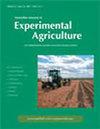Diversity of methanogens in ruminants in Queensland
引用次数: 29
Abstract
Methane emissions from ruminant livestock represent a loss of carbon during feed conversion, which has implications for both animal productivity and the environment because this gas is considered to be one of the more potent forms of greenhouses gases contributing to global warming. Many strategies to reduce emissions are targeting the methanogens that inhabit the rumen, but such an approach can only be successful if it targets all the major groups of ruminant methanogens. Therefore, a thorough knowledge of the diversity of these microbes in different breeds of cattle and sheep, as well as in response to different diets, is required. A study was undertaken using the molecular techniques denaturing gradient gel electrophoresis, DNA cloning and DNA sequence analysis to define the extent of diversity among methanogens in ruminants, particularly Bos indicus cross cattle, on differing forages in Queensland. It was found that the diversity of methanogens in forage-fed cattle in Queensland was greater than in grain-fed cattle but there was little variability in methanogen community composition between cattle fed different forages. The species that dominate the rumen microbial communities of B. indicus cross cattle are from the genus Methanobrevibacter, although rumen-fluid inoculated digestors fed Leucaena leucocephala leaf were populated with Methanosphaera-like strains, with the Methanobrevibacter-like strains displaced. If ruminant methane emissions are to be reduced, then antimethanogen bioactives that target both broad groups of ruminant methanogens are most likely to be needed, and as a part of an integrated suite of approaches that redirect rumen fermentation towards other more useful end products.昆士兰反刍动物产甲烷菌的多样性
反刍牲畜的甲烷排放代表了饲料转化过程中碳的损失,这对动物生产力和环境都有影响,因为这种气体被认为是导致全球变暖的更有效的温室气体之一。许多减少排放的策略都是针对瘤胃中的产甲烷菌,但这种方法只有针对所有主要的反刍动物产甲烷菌群才能成功。因此,需要全面了解这些微生物在不同品种的牛羊身上的多样性,以及它们对不同饮食的反应。利用分子变性梯度凝胶电泳、DNA克隆和DNA序列分析等技术,研究了昆士兰不同牧草上反刍动物(特别是杂交牛)产甲烷菌的多样性程度。结果表明,昆士兰草饲牛产甲烷菌群落多样性高于粗粮饲牛,但不同草饲牛产甲烷菌群落组成差异不大。在杂交牛瘤胃微生物群落中占主导地位的菌种是甲烷预防菌属,但在瘤胃液接种过的消化器中,以白毛藻叶为饲料的瘤胃中存在类似甲烷菌的菌种,而类似甲烷预防菌的菌种被取代。如果要减少反刍动物的甲烷排放,那么最有可能需要针对反刍动物产甲烷菌的广泛群体的抗产甲烷菌生物活性物质,并且作为将瘤胃发酵转向其他更有用的最终产品的综合方法的一部分。
本文章由计算机程序翻译,如有差异,请以英文原文为准。
求助全文
约1分钟内获得全文
求助全文

 求助内容:
求助内容: 应助结果提醒方式:
应助结果提醒方式:


